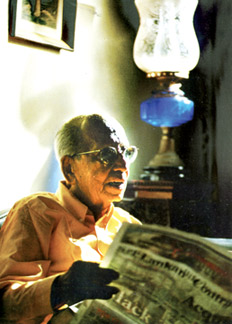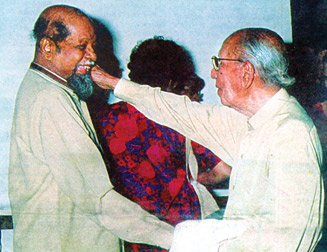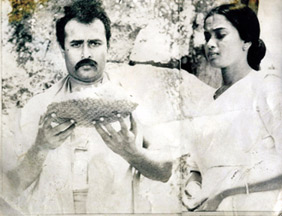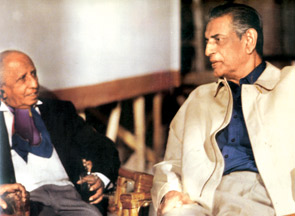|
Glimpse into the life and times of Lester James
Peries on his 91st birthday :
On the trail of doyen of Sinhala cinema
by Ranga Chandrarathne
 |
|
Dr. Lester James Peries |
A singular characteristic of the brilliant career in cinema of Lester
James Peries is his production of canon defining Rekava which was a
watershed in the annals of Sri Lankan filmdom. Apart from deviating from
the beaten track of producing prototype North Indian melodrama films,
Rekava paved the way for the production of artistic tradition of
Sinhalese cinema.
 |
|
A memorable moment with
Regi Siriwardane |
Another important aspect, albeit not counted at the time of the
production of Rekava, is that it stamps in the authority of the
authorship of director or filmmaker. Lester was greatly influenced by
the tradition of documentary filmmaking and the realistic Italian cinema
of the day. Nidhanaya (The Treasure-1970) was the finest film that
Lester James Peries made. Nidhanaya which was based on a short story by
G. B. Senanayake, was marked among other things, for its brilliant
exploration of complex psychologies and Lester's ability to extract best
performances out of Gamini Fonseka and Malini Fonseka. It magnificently
blended the story with the cinematography.
As Dr. Lester James Peries marks his 91st birthday, it is pertinent
to traverse the beaten track which paved the way for modern Sinhalese
films. Apart from his numerous documentaries some of which he made in
London such as Soliloquy (1949), Farewell to Childhood (1950) and
Sinhalese Dance (1950), and those he made whilst in the Government Film
Unit, one of the significant developments in his career in filmmaking
was the production of Rekava which was a canon defining first outdoor
shot Sinhala film. It was a groundbreaking venture albeit it was a box
office failure. It can be considered as the forerunner to the modern
Sinhala film.
The earliest Sinhala films were formulaic and melodramas on
celluloid. Films including the first Sinhala film Kadavuna Poronduva
(Broken Promise), Kapati Arakshkaya (Cunning Guardian), Veradunu
Kurumanama (Defeated Aim-1949) and Kela Handa (Wild Moon-1953) and
Sujatha (1953) were melodramatic in essence. It was these prototype
films that made sensibilities of filmgoers in Sri Lanka. Even the
Sinhalese intelligentsia did not consider Sinhala films as a serious
mode of entertainment. The plot and even the beginning and the end of
the films were predictable.
Gamperaliya as an artistic film
 |
|
Gamini Fonseka and
Malini Fonseka in Nidhanaya |
 |
|
Dr. Lester James Peries
with Satyajith Ray |
At a time Sinhala cinema was dominated by such melodramas in
celluloid, Lester James Peries produced Gamperaliya (The Changing
village) in 1963.
The production of Gamperaliya as one of the 20 films by Lester James
Peries marks an important landmark in the evolution of Sinhala cinema.
The film was instantly recognised by both Westernised and local
intelligentsia as a cinematic masterpiece made out of a masterpiece in
literature by Martin Wickremasinghe. Gamperaliya was awarded Grand Prix
(Golden Peacock) at the Indian International Film Festival held in
Delhi.
A significant fact is that the jury which selected Gamperaliya was
made up of eminent personalities in the industry such as Lindsay
Anderson, Andrej Wajda, George Sadoul and Satyajith Ray. Satyajit Ray
hailed the film as "poetry and sensitivity with which it explores and
illuminates personal relations".
It marked a new chapter in Sinhala film as for the first time,
filmgoers recognising the immense potentials latent in the media in
exploring the life in an artistic manner.
Gamperaliya was recently fully restored as restored classic and
commercially released in France. Among other things, it is considered as
one of the best ten films made in the 20th century.
Similar in plot to Anton Chekov's Cherry Orchard, Gamperaliya deals
with the collapse of feudalism and the uneasy social transformation to a
fully-fledged capitalism with the rise of the middle class as a dominant
group in the society. This uneasy transition and the collapse of the
feudal class is depicted through the gradual decline of the social
status of the family of Kaisaruwatte Huhamdiram and Matara Hamine who
represent the decaying social order while rise in social status of young
entrepreneur Piyal symbolises the rise of the middle class.
Martin Wickremasinghe published Gamperaliya in 1945 and it was
immediately recognised as a masterpiece in Sinhala literature.
Gamperaliya, among other things, was marked for the authentic depiction
of peasant society of Sri Lanka in transition and complex portrayal of
characters and the milieu. Gamperaliya is considered as the birth of
artistic tradition of filmmaking in Sri Lanka. On another plane,
Gamperaliya is the cinematic culmination of a cultural and literary
renaissance of the 1950s.
Another important aspect of Gamperaliya's contribution to the growth
of Sinhala cinema is that it established the authority of the director.
Until Lester James Peries came into Sinhala cinema, the role of a
director had not been recognised. In fact, in most of the melodrama
films, director played little or absolutely no role in the creation of
the film. However, throughout Lester James Peries's career in
filmmaking, his signature is imprinted on the films he made. Peries's
films were characteristic of his unique non-dramatic style where the
natural delivery of dialogues was encouraged as opposed to theatre like
inanimate and monotonous dialogues, content and vision.
 |
|
A scene from
Goluhadawatha |
Although often neglected by critics, Lester's sympathetic view
towards women in not emotional way is manifested amply in some of his
creations such as Gamperaliya, Nidhanaya (The Treasure/ 1970), Ahasin
Polovata (White Flowers for the Dead/1976) and Wekanda Walawwa (Mansion
by the Lake/ 2001-2002). His was a marked deviation of the portrayal of
women in Sinhala cinema in that the complexities of women were explored.
For instance, the character of Nanda in Gamperaliya is a complex women
character. Nidhanaya (The Treasure/ 1970) was one of the internationally
acclaimed films by Lester James Peries. It explores the psychology of
characters and is marked for the delicate fusion between content and
style. Lester also shows his maturity as a master craftsman in eliciting
the best performance out of the cast. Particularly the performance of
the lead roles by Gamini and Malini Fonseka is remarkable. Prof. Wimal
Dissanayake states "Nidhanaya demonstrated very clearly that Sri Lankan
Cinema was capable of producing works that could hold their own with the
best anywhere in the world.
This is a stylish, absorbing and well integrated film in which a
stern aesthetic guides the flow of the image". Lester James Peries is
realistic filmmaker and his realism is an essential characteristic of
his poetics of cinema. However, he offers a rather broader perspective
of realism and is marked for non-dramatic depiction.
Lester James Peries's works can only be appreciated against the
milieu and in the context he made his remarkable creations which are not
only part of artistic legacy of the nation but also that of humanity.
|

